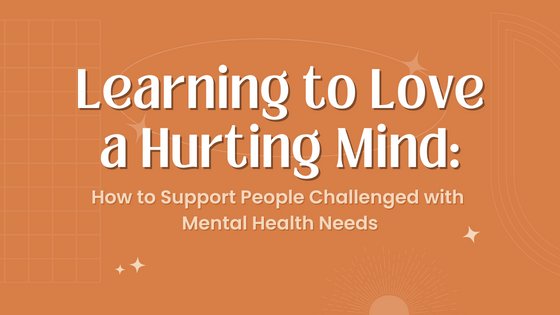Warning: If certain mental health topics like su!c!de, $elf-h@rm, or e@ting disorders trigger you, please be aware that this post mentions them. There is no pressure to read this, and your health and well-being come first. Please take care of yourself and your needs.
One of the first things that professionals teach you in a Mental Health First Aid course is that the language around mental health must change. Instead of people having mental health issues, they have mental health challenges.
This subtle word change makes a world of difference. Instead of people being bogged down by issues and problems, they are challenged with battles and fights. This change removes a long-held stigma against mental health needs by getting rid of the concept of mental health being a burden or a hindrance. It places the nature of such needs in a more positive light, humanizing those who are struggling and normalizing the fact that there is a need.
The National Institute for Health defines a mental illness as, “a mental, behavioral, or emotional disorder. Mental illnesses can vary in impact, ranging from no impairment to mild, moderate, or even severe impairment.” This impairment can take many forms, most often in the decline of a person’s well-being: their healthy behaviors, social connectedness, productivity, longevity, and more. The following sections form a generalized list of the most common disorders and how they manifest in a person.
First, mood disorders. Mood disorders are currently the best researched mental illness. Primarily affecting a person’s emotional state, these disorders have to do with the fluctuation of a person’s mood for an extended period. Along with altering emotions, these disorders can severely influence a person’s behavior. Types of disorders include depression and its subtypes, bipolar disorder, premenstrual dysphoric disorder, and disruptive mood dysregulation disorder, and more yet unidentified, nameless disorders. Depressive symptoms include a lack of energy, difficulty concentrating, irregular sleep patterns, and feelings of worthlessness or hopelessness usually combined with suicidal ideation and self-harming tendencies. They can surface at many different seasons in life based on many environmental factors, but the result is always the struggle to find a sense of emotional and behavioral stability. Meanwhile hypomanic or manic symptoms include extreme energy, restlessness, irritability, excessive risk-taking and recklessness, and insomnia.
A personal testimony described a major depressive episode as “constantly colorless and bleak and numb.” They spoke about how it felt like “days on end of slogging through muck while getting absolutely nowhere,” not being able to get out of bed or motivate themselves to eat.” This individual’s reaction had been sparked by a conversation with an acquaintance and endured for about three and a half weeks to a month.
Next, anxiety disorders. Anxiety disorders are the most common mental illness with 30% of US adults experiencing them at some point. They can interfere with day-to-day tasks as a person loses control of their response in a situation. Typical types of anxiety disorders are a generalized anxiety disorder (GAD), panic disorders, extreme phobias, separation anxiety and more. Many other mental health challenges overlap with anxiety disorders, sharing many symptoms and experiences. Symptoms for anxiety include extreme uneasiness and restlessness, unrealistic worry, and difficulty focusing. This can arise in many situations, but those with social anxiety disorder can suffer even more acutely than others. They can have an intense fear and overwhelming self-consciousness when they are in public or crowds. A more extreme situation for anxiety is known as a panic attack. People begin sweating, feel chest pain and difficulty breathing, feel like their heart is pounding as their thoughts spin out of control. Someone experiences a phobia when they feel an intense fear towards something that does not match that situation or object. Some even have what is known as agoraphobia or the intense fear of being unable to get help in unfamiliar places like public transportation, enclosed areas, or large crowds.
Next, personality disorders. Personality disorders are among the most difficult mental illnesses to live with given that they disrupt behavior and social functioning. There are three clusters of personality disorders: Cluster A, which are predominantly categorized by interpersonal difficulties such as paranoia, disinterest, and discomfort; Cluster B, which are usually categorized by more erratic behaviors like acting out against social norms, poor emotional regulation, extreme approval seeking, and narcissistic behaviors; and Cluster C, which are categorized by severe anxiety and fear manifesting in ways such as chronic feelings of inadequacy, extreme submissiveness, and extreme need for control without self-awareness.
Next, eating disorders. Eating disorders, while some of the easiest illnesses to find treatment for, are among the most common. More than thirty million individuals have an eating disorder at any given time. There are three types: 1) Anorexia nervosa, where individuals refuse to give their body the food and nutrition it needs because they want to lose weight; 2) Bulimia nervosa, where individuals binge eat large amount before forcing themselves to vomit it back up or purge the calories in other ways like exercise; and 3) Binge eating disorder (BED), where individuals experience no control over their eating without burning off the calories and dealing with shame and guilt afterwards.
Stories can be found everywhere about experiences with eating disorders. People describe looking in the mirror to find someone who looks like they weigh 50 pounds more than what they actually are. They describe feeling guilty and ashamed about eating less than a serving size because they thought it was “too much.” Men, women, teens, and children are all susceptible to developing this disorder.
Next, ADHD. While attention-deficit/hyperactivity disorder (ADHD) is technically a neurodevelopmental disorder, it manifests in ways very similar to other mental illnesses. It typically appears before the age of ten, and about half of diagnosed cases persist into adulthood. Symptoms include inattentiveness, impulsivity, and hyperactivity. Each case presents slightly differently, but for the most part an individual either presents predominantly inattentive, predominantly hyperactive/impulsive, or a combination of both. ADHD can often feed into experiences with anxiety, depression, and other challenges if the individual is unable to manage their symptoms.
Next, addiction disorders. Different forms of addiction are usually very closely related to mental illnesses. Anyone who struggles with addiction often also has a mental health challenge like depression or anxiety to address as well, which can be a reason that they turned to substances in the first place. If an individual uses or becomes addicted to substances, they can alter their brain chemistry making permanent recovery more difficult.
The truth in all these conditions is that the person suffering does not have control. It may be over their emotions, their physical reactions, their impulses, or their behavior, but the base fact remains the same that their brain or body does not operate in a ‘normal’ manner. Some actions or mindsets may seem unconscionable to us, but for those suffering, those things are chemically and biologically out of their control. Their brain and their body have adapted to survive through unhealthy or irregular means. Survival is sometimes the best that they can manage while dealing with the overwhelming amounts of emotions that are associated with all of these conditions.
We will discuss the causes of each of these tomorrow, but for now think of how we can serve people experiencing these trials now. What common ground can you find in their emotions, and how can you empathize?
As a note: Please do not use this post in any other way than as a springboard into more research.
– Maria Lotti, YES Intern

